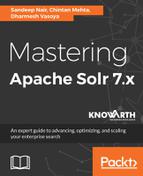Doug Cutting created Lucene in 2000, which is the core technology behind Solr.
Solr was made in 2004 by Yonik Seeley at CNET Networks for a homegrown project to provide search capability for the CNET Networks website.
Later in 2006, CNET Networks published the Solr source code to ASF. By early 2007, Solr had found its place in some of the top projects. It was then that Solr kept on adding new features to attract customers and contributors.
Solr 1.3 was released in September 2008. It included major performance enhancements and features such as distributed search.
In January 2009, Yonik Seeley, Grant Ingersoll, and Erik Hatcher joined Lucidworks; they are the prime faces of Solr and enterprise search. Lucidworks started providing commercial support and training for Solr.
Solr 1.4 was released in November 2009. Solr had never stopped providing enhancements; 1.4 was no exception, with indexing, searching, faceting, rich document processing, database integration, plugins, and more.
In 2011, Solr versioning was revised to match up with the versions of Lucene. Sometime in 2010, the Lucence and Solr projects were merged; Solr had then became an integral subproject of Lucene. Solr downloads were still available separately; however, it was developed together by the same set of contributors. Solr was then marked as 3.1.
Solr 4.0 was released in October 2012, which introduced the SolrCloud feature. There were a number of follow-ups released over a couple of years in the 4.x line. Solr kept on adding new features, becoming more scalable and further focusing on reliability.
Solr 5.0 was released in February 2015. It was with this release that official support for the WAR bundle package ended. It was packaged as a standalone application. And later, in version 5.3, it also included an authentication and authorization framework.
Solr 6.0 was released in April 2016. It included support for executing parallel SQL queries across SolrCloud. It also included stream expression support and JDBC driver for the SQL interface.
Finally, Solr 7.0 was released in September 2017, followed by 7.1.0 in October 2017, as shown in the following diagram. We will discuss the new features as we move ahead in this chapter, in the What is new in Solr 7 section.

We have depicted the history of Solr in the preceding image for a much better view and understanding.
So by now, we have a brief understanding of Solr, along with its history. We must also have a good understanding of why we should be using Solr. Let's get the answer to this question too.
